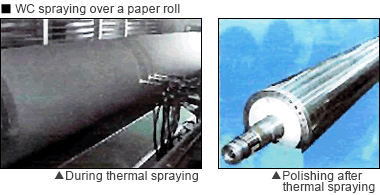#330 Structure of Thermal Spraying Films-1
(1)Characteristics of the films
The structure of film sprayed in the air is extremely complex and has the following characteristics:
| 1. | It is a buildup of particles having boundaries. | |
| 2. | It has pores. | |
| 3. | It contains oxidation products. | |
| 4. | Residual stress exists. | |
| 5. | The material and film compositions may change before and after thermal spraying. | |
| 6. | Both unmelted and semi-molten particles may be present. | |
| 7. | The film has a rough surface. | |
| 8. | The films are mainly bonded mechanically, but metallurgical bonding may occur depending on the spraying method. |
[Fig.1] is the schematic diagram of a film structure.
![[Fig.1] Schematic diagram of a thermal spraying film section [Fig.1] Schematic diagram of a thermal spraying film section](/tt/en/surface/138_1.gif)
(2)onding mechanism of the film
The substrate and spray particles are generally bonded by the combined actions of the following: mechanical bonding (anchor effect) where particles attach to the concave and convex portions of the substrate's rough surface, metallurgical bonding, and/or physical bonding caused by intermolecular attractions, such as Van der Waals force.
The bonding mechanism varies by the substrate materials and surface shapes. For example, when using plasma spraying of Mo, Ta, and W on a steel or aluminum substrate, there will be a localized area that is bonded by metallurgical reactions resulting from diffusion.In addition to the mechanical bonding, the spray particles are bonded by the diffusion of hydrogen ions or metallic ions that are reciprocally generated during collisions of the particles between the oxide films.
One of the methods of increasing the adhesion properties would be to spray in a thin layer of materials that are known to bind strongly between the substrate and the film, such as Mo, W, Ni-AL, Ni-Cr.This method is called "bonding coat". The films formed by this method will alleviate heat expansion between the substrate and the thermal spraying film, while improving corrosion resistance and adhesiveness.The bonding coat is usually applied before spraying oxide ceramics.

- Environmental conservation
- Hot Dipping
- Anodic Oxidation Process
- Anodic oxidation treatment
- Anodizing
- Corrosion - Corrosion Protection
- Electroless Plating
- Electroplating
- Heat treating
- Hydrogen embrittlement
- Metal cleaning
- Metal etching
- Painting
- Special paints
- Surface Treatment
- Surface-treated steel sheets
- Thermal Spraying



